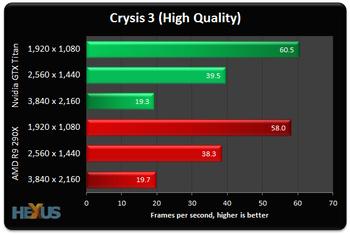Crysis 3 at 4K. Yeah, right
Just yesterday, we found out that AMD's new champion graphics card, the $549 Radeon R9 290X, gave Nvidia's GeForce GTX Titan a very good run for its money. Heck, in some games it took the Titan's dinner money and gave it a cheeky slap into the financial bargain.
Taken over the results from benchmarks conducted at a tasty 2,560x1,440-pixel resolution and evaluated over six modern games, the R9 290X has the slightest of edges over the Titan. This is good news for consumers as there's now real choice in every segment of the discrete graphics-card market.
Using our high/ultra-quality settings does little to dampen the sheer horsepower evident on both sides of the graphics fence. Sure, Crysis 3 runs a little slow, but when does it not, and other games tend to average 60fps at 2,560x1,440. AMD also proclaims the R9 290X to be a very good fit for 4K panels sporting a native resolution of 3,840x2,160.
So, just as before, we've run the best two cards at 4K on an Asus PQ321Q monitor kindly provided by the company. In-game image-quality settings range from high to ultra-high, and you can find a full breakdown of the testing methodology and equipment here. Note that we're continuing to use lots of GPU-bustin' antialiasing, to really put the hurt on the cards. The results will prove whether it's possible to game on a 4K-resolution screen, with top-notch settings, using the very best single-GPU graphics cards that money can buy.
Let's begin by taking a look at performance in the most punishing game of all - Crysis 3.
Crysis 3 is a beautiful-looking game that continues to tax high-end systems. We've FRAPS'd a 30-second section near the start of the game, with lashing rain, numerous reflections and full DX11 pomp on show.
Remember that image-quality settings don't change when spanning resolutions. Performance is just about acceptable at 2,560x1,440 but halves when moving to 4K. This makes implicit sense as the pixel-load is more than doubled - 8.29MP vs. 3.68MP - between the two settings.
Both GPUs have monster backends - necessary for running AA at ultra-high resolutions - and large framebuffers. Performance is very similar, as you can see from the per-second graph below.
Looking at the per-second results shows the two headline GPUs match one another throughout our test section. Framebuffer usage spikes to around 3.5GB, which is within the 4GB of the R9 290X and well inside the 6GB-equipped Titan. One would need a GPU fundamentally more powerful to manage 30fps, such is the hurt imposed by these settings. Turn the visual wick up to 'very high' and you can almost hear the cards squeaking in pain.





